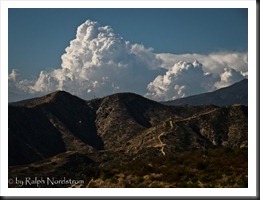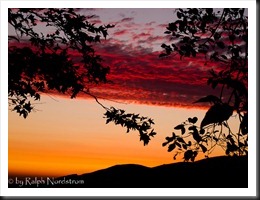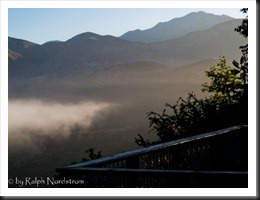One of the things that we landscape photographers pay a lot of attention to is light. In fact, it is my belief that the study of landscape photography is a never ending study of light. And that’s a good thing because there’s so much to learn.
Now, I must confess – my analytical mind needs to break things down to help my creative mind better recognize and capitalize on great light. So get ready ‘cause here come a series of blog posts on light.
What Color Is a Cloud?
The first thing I want to look at is Color. Now, we’re all pretty familiar with red, green and blue, even cyan, magenta and yellow. I don’t want to talk about color in that way. We could discuss the color wheel and that would be informative but, well, not all that exciting. I’d like to kick this off by asking a simple question…
The answer is easy? White? Well yes.
And no.
You see, we can’t really say anything about the color of an object like a cloud without knowing another important factor.
So let me ask the question again, “What color is a cloud?”
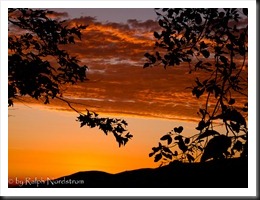 Here’s a different answer. Oh, golden you say?
Here’s a different answer. Oh, golden you say?
Again, yes.
And no.
What’s the difference between the two clouds? It’s the color of the light that is illuminating them.
In the first photograph the clouds are illuminate by mid-day sunlight. In the second photograph the clouds are illuminated by the setting sun.
So again, what is the color of a cloud?
Oh, red you say?
Again, yes and no.
As the sun drops farther below the horizon the color it leaves behind changes from golden to red to pink.
So it’s not really the clouds that are changing color but the sunlight that is illuminating them. And it’s the sunlight that is changing color from when it’s high in the sky to when it drops down to the horizon and eventually sinks below it. Why is this? Because the color of sunlight is affected by the atmosphere trough which it passes.
By the way, the sunlight of mid-day is considered to be our reference color. This is our white; the light has not bias or cast. We talk about colors in reference to daylight or, more precisely, mid-day light. If the light is bluish it is considered cool. If it’s reddish it’s considered warm. Enough of that. Back to the position of the sun in the sky.
When it’s directly overhead the atmosphere it passes through is relatively thin, most of which is within the first ten miles or so. But when the sun is low in the sky it passes through much more atmosphere and the blue light is scattered leaving the warm golden rays to reach us. This is what gives us the Golden Hour light we so prize, the hour after sunrise and before sunset. If you would like to read more scientific explanations about this here’s a nice Wikipedia article on Rayleigh scattering.
To recap up to this point, the color of a cloud is determined by the color of the sunlight falling on it.
But is that all? Let’s ask the question again. What color is a cloud?
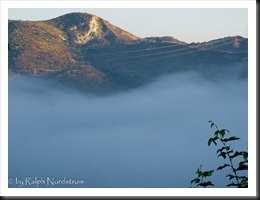 We can’t use sunlight to explain the blue coloring of this lovely fog. And yet it is definitely blue. (Fog is most certainly a cloud, just one that is resting on the ground.)
We can’t use sunlight to explain the blue coloring of this lovely fog. And yet it is definitely blue. (Fog is most certainly a cloud, just one that is resting on the ground.)
So why is this cloud blue? The sun isn’t shining on it. What is its source of illumination then? Often in my workshops people look at me like I’m crazy when I give them the answer. But it’s true. The blue sky is the source of illumination.
We don’t often think of the sky as a light source but it is. And since it’s blue (at least during the middle of the day) the light it casts on objects is blue. Of course, the sky can also turn golden and red at sunrise and sunset. Why, if you look carefully at those times of day you will even see green in the sky. Don’t believe me? Check it out.
In just a few minutes the sun that is shining on the mountain top in the background will touch the clouds and their color will change.
Same morning, same clouds, different light. Now the clouds have lost their blue cast and are yellowish. They just went from the sky being the source of illumination and color to the morning sun.
Let’s look at another example.
What is the color of a cloud?
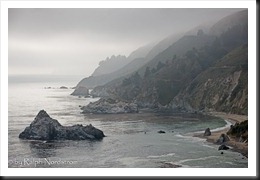 On an overcast day the color of clouds is off white or gray. And now the clouds become the light source and impart their gray light on everything.
On an overcast day the color of clouds is off white or gray. And now the clouds become the light source and impart their gray light on everything.
But, truth to tell, the light on overcast days is not neutral gray. Sunlight is falling on the tops of the clouds and the light filters through. As it does a little of the reds, yellows and oranges are scattered by the water droplets and the light emerging from the bottom of the clouds is slightly blue. We’ll come back to this when we talk about White Balance in a later post.
So, what color is a cloud?
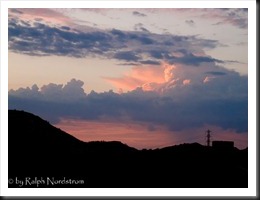 The answer is it takes on the color of the source of illumination. And an important thing to realize is that the source of illumination is not always the sun but can be the blue sky or the golden sky or the pink sky.
The answer is it takes on the color of the source of illumination. And an important thing to realize is that the source of illumination is not always the sun but can be the blue sky or the golden sky or the pink sky.
What’s the lesson to learn here?
I chose clouds as our subject because they take on the colors of the light sources. But all objects take on the colors of their light sources to varying degrees. It’s just that clouds are so obvious about it (because they’re white). I could have used snow just as well except it’s in short supply here in Southern California.
So, lesson number one is the color of the light source influences the color of the object. And lesson number two is that there are many sources of light out there including the sun, the sky, overcast clouds and more.
I’ll leave you with this true story. When my daughter was three I was driving her home from daycare. The sun was just above the horizon and it was a particularly bright and warm sunset (one of the few benefits of California smog I’m afraid). We were driving through a residential area and my daughter exclaimed, “Look daddy, the leaves are red!” No, it wasn’t autumn. We don’t get autumn in Southern California. The leaves were green but the red in the light of the setting sun was so intense that the leaves did indeed look red.
Color Exercises
Here’s an exercise for you. Become aware of the sources of light that illuminates the objects around you. Then become sensitive to the color cast they impart on the objects. A good place to start is with the blue sky and the effect it has on the color of shadows. Train yourself so you can actually see that shadows are blue. (Can you explain why?)
Then look for other sources of light such as the sunlit wall of a building. What effect does it have on the color of nearby objects?
As you expand your awareness of sources of light, their colors and the effect they have on the world you will better understand one of the many fascinating properties of light. And you will be able to better utilize this property in creative ways in your photography.
We do photography workshops. Come on out and join us. Click here to check us out.
You can also check out our photography. Click here.
(1555)

